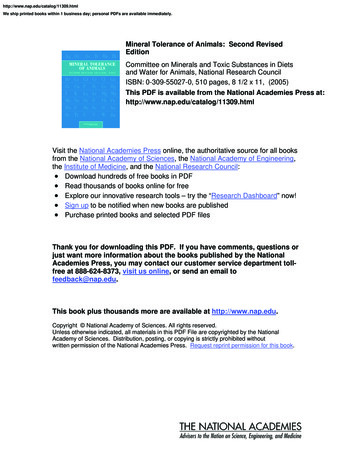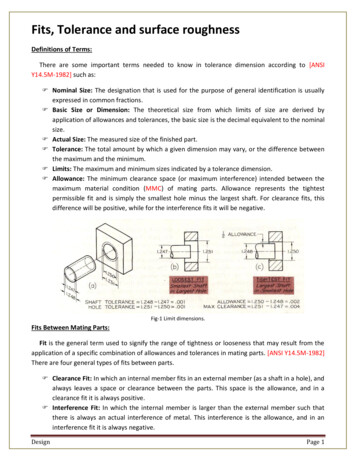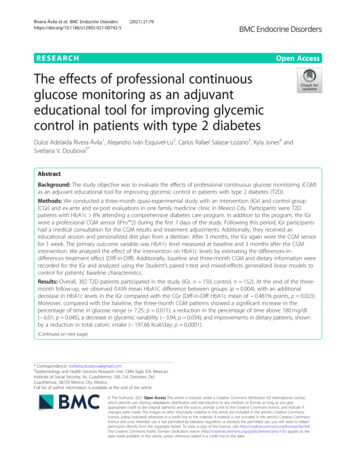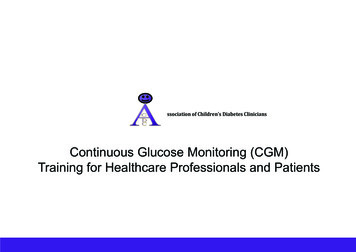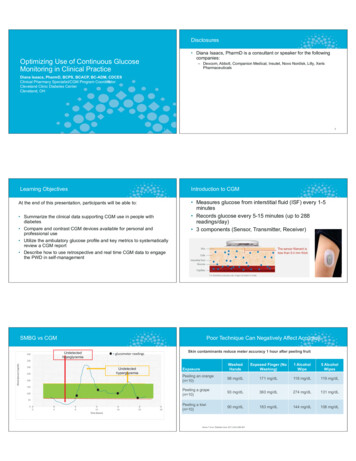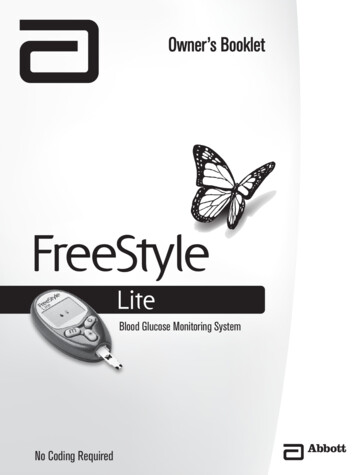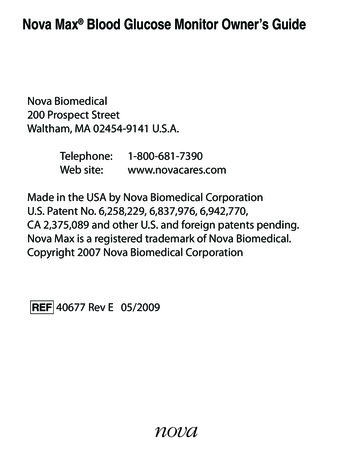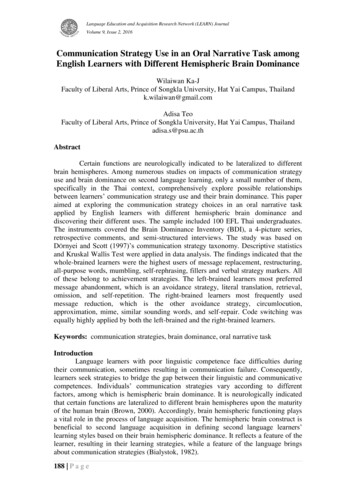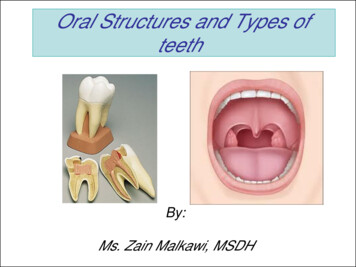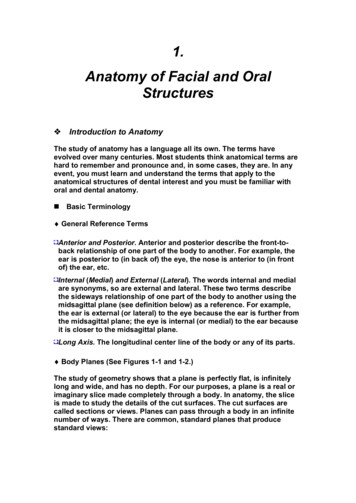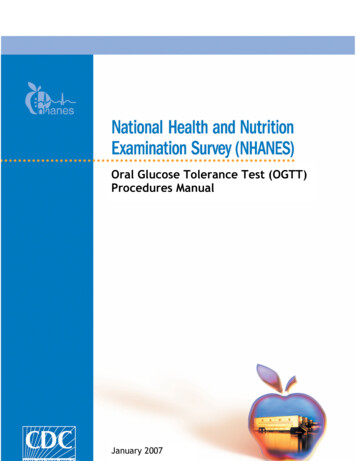
Transcription
Oral Glucose Tolerance Test (OGTT)Procedures ManualJanuary 2007
TABLE OF CONTENTSChapter12PageOVERVIEW OF THE ORAL GLUCOSE TOLERANCE TEST (OGTT).1-11.11.21.3Introduction.Field Office Responsibilities .MEC Overview .1-11-21-4COORDINATOR APPLICATION .2-12.12.22.32.42.5Coordinator Responsibilities.Application Overview.Coordinator Progress Bar Colors .Priorities and Verification Form .Exclusion Criteria and Shared Exclusion Pregnancy Question .9-Hour Fast Requirement .No Tubes Drawn .Less than 1 Hour and 40 Minute Blocking .Return Time Expired Blocking .2-122-152-172-182-19Coordinator Messaging.Assigning an Examiner and SP to the OGTT Component.2-202-262.62.73TRUTOL ADMINISTRATION OGTT APPLICATION .3-13.13.23.33.43.5MEC Staff Responsibilities .Equipment and Supplies .Gaining Cooperation.Exclusion Criteria .OGTT Application Overview .3-13-13-33-53-63.5.1Introduce Exam to SP.3-7OGTT Section 1 - Exclusion Questions and Trutol cording Responses to the Exclusion Questions .Trutol Administer Information.Section Status .iii
TABLE OF CONTENTS (continued)Chapter456PageBLOOD DRAW OGTT APPLICATION.4-14.1OGTT Application – Section Two (Blood Draw) .4-1LABORATORY ratory Overview.Process the 2-mL Gray Top Tube for OGTT.Record the Results of Specimen Processing .Vessel 98 Storage Protocol .Vessel 98 Shipping Protocol.SPANISH SPEAKING SPs .6-16.16.26-16-1Performing the OGTT on SPs Who Do Not Speak English .Convert Screen Text to English or Spanish .List of ExhibitsExhibit1-1Informational flyer for Oral Glucose Tolerance Test, aged 12 yearsand older .1-32-1Verification form – a.m. session .2-72-2Verification form – p.m. session.2-83-1Equipment and supplies – OGTT .3-23-2Talking Points - English .3-73-3Talking Points – Spanish .3-83-4Trutol Calibrated Dosage Chart .3-235-1Primary SP’s OGTT processing protocol .5-15-2Storage protocol for GTT .5-135-3GTT shipping protocol.5-135-4Contract laboratory addresses .5-14iv
1. OVERVIEW OF THE ORAL GLUCOSE TOLERANCE TEST (OGTT)1.1IntroductionBecause of the increasing occurrence of diabetes in younger ages, NHANES has added thiscomponent to the examination protocol to reassess the prevalence of diabetes and impaired glucosetolerance (IGT) in the U.S. population.Diabetes is a large, growing, and costly public health problem in the United States anddisproportionately affects racial and ethnic minorities. About 17 million Americans have diabetes andover 1 million new cases of diabetes are diagnosed each year. Diabetes is the leading cause of kidneyfailure, nontraumatic lower extremity amputation, and blindness in working-age adults, and an estimated 135 billion was spent on direct and indirect medical costs for diabetes in 2002. Alarmingly, type 2diabetes (formerly considered an adult disease) is now being diagnosed in children and adolescents andthere has been a large increase in diagnosed diabetes among adults 40 years of age.Persons with IGT – 15.6 percent of the U.S. population – are at high risk for developingdiabetes. In addition, IGT is an important risk factor for a number of other adverse health conditions andmortality. IGT is defined on the basis of an abnormal oral glucose tolerance test (OGTT). Persons withoutdiabetes but with an OGTT 2-hour value of 140-199 mg/dl are considered to have IGT.Recent national and international randomized controlled trials have shown that diabetes canbe delayed or prevented among persons with IGT. Furthermore, NHANES III data indicate a tremendousopportunity for the prevention of diabetes—over 12 million persons aged 45-74 have prediabetes (definedas overweight persons with either IGT or impaired fasting glucose metabolism). These data also indicatethat over 50 percent of persons with prediabetes are detected only by IGT findings. As risk factors fordiabetes, IGT, and prediabetes increase (e.g., physical inactivity, obesity, and aging), the prevalence ofthese conditions is also likely to increase.The inclusion of OGTTs on NHANES will allow estimation of the prevalence of IGT and,thus, prediabetes in the U.S. population, surveillance of trends in the prevalence and awareness of theseconditions, study of the risk factors for IGT and prediabetes, and examination of IGT as a risk factor forhealth conditions and mortality. Timely data on IGT and prediabetes are particularly important as the1-1
Nation initiates efforts to prevent diabetes among persons with prediabetes. These data on IGT andprediabetes are critical to targeting, designing, and evaluating prevention efforts such as DHHS’s STEPSprogram and efforts by the National Diabetes Education Program.A fasting glucose blood test is performed on all participants 12 years and older who areexamined in the morning session after a 9-hour fast. After the initial venipuncture, participants are askedto drink a calibrated dose (generally 75 milligrams) of Trutol and to have a second venipuncture 2 hours(plus or minus 15 minutes) after drinking the Trutol.There are minimal risks associated with this procedure. The package label for Trutol lists thefollowing rare but known adverse reactions: nausea, vomiting, abdominal bloating, and headache. Inaddition, there is a rare incidence of hypoglycemia. The risks associated with venipuncture includeexcessive bleeding, fainting/feeling lightheaded, hematoma, infection, and multiple punctures to identifyveins. Participants eligible for OGTT will have to endure the discomfort of a second venipuncture;however, they will benefit by the report of findings that will inform them if they have impaired glucosetolerance.The results from the OGTT will be reported to parents of participants 12-17 years anddirectly to participants 18 years and older in the Final Report of Findings. If the 2-hour blood glucosevalues are equal to or greater than 140 mg/dL, (i.e., glucose levels consistent with impaired glucosetolerance or diabetes mellitus), an early report will be sent.1.2Field Office ResponsibilitiesThe field office is responsible for instructing SPs to fast and for introducing the OGTTduring the household interview by using an informational flyer (Exhibit 1-1). There is no change to theexisting fasting remuneration.1-2
Exhibit 1-1. Informational flyer for Oral Glucose Tolerance Test, aged 12 years and olderOral Glucose Tolerance Test, aged 12 years and olderWhy are we asking participants to have an Oral Glucose Tolerance test (OGTT)?We are asking teenagers and adults who are examined in the morning exam session to have an OGTT sowe can learn more about how many people in the United States have diabetes.Why is the study of diabetes in teenagers important?Doctors and other health workers have seen an increase of type 2 diabetes in teenagers and adults over thepast 20 years. This is an important problem since it can lead to many health problems such as heartdisease, poor circulation, and blindness.What is diabetes?Diabetes mellitus is a group of diseases that cause high blood sugar levels. Type 1 diabetes was calledinsulin-dependent diabetes or juvenile diabetes and develops when the body’s immune systems destroythe cells that make the hormone insulin that controls blood sugar levels. Type 2 diabetes was previouslycalled non-insulin diabetes or adult-onset diabetes. Type 2 diabetes happens when the cells in our body donot use insulin right. In the past it was seen mostly in old people, overweight people, and people whowere inactive. Today, type 2 diabetes is seen more and more in children and teenagers.What will participants have to do to have the OGTT test?Participants aged 12 years and older who are examined in the morning will be asked not to eat or drinkanything (EXCEPT WATER) 9 hours before coming to the exam center. They will have their blooddrawn for laboratory tests that include a fasting glucose test. They will then drink a special sugar drink.After 2 hours they will have more blood drawn to see how their body handled the sugar they drank.What will this test tell participants about their health?This test measures how the body handles sugar. We will be able to tell if a person is at risk for diabetes oralready has it. The person or his or her parents will be told if the test shows a blood sugar problem.Consent:Page 3 of the consent brochure has been modified as follows:Safety of TestsWe chose the tests and measurements because they are safe. Some of the exams or procedures may causeyou slight discomfort. Examples are collecting a blood sample or fasting for 9 hours. For the bloodsample, a person will have a small amount of blood drawn from a vein in his or her arm with a needle.Participants 12 years and older with a morning appointment will be asked to drink a sugar solution andhave blood taken a second time. Although rare, the sugar solution can cause nausea, vomiting, bloating,or headache. We will not ask you to have any test or procedure that is wrong for you because of a healthproblem or condition.1-3
1.3MEC OverviewDiabetics taking insulin who are assigned to morning sessions are asked to fast for 9 hoursso these SPs will be assigned to phlebotomy as the highest priority. They are not eligible for the GTT.SPs aged 12 and older assigned to the morning session who have fasted for 9 hours areeligible for the GTT. It is generally important to assign SPs aged 12 and older to phlebotomy as soon aspossible at the start of a session, but it is especially important during a morning session. It is alsoimportant to assess the fasting status of SPs aged 12 and older assigned to a morning session because theyare not eligible for the GT examination if they have not met their 9-hour fast requirement. Thecoordinator gives each SP a hard-copy verification form as part of the check-in process. For SPs aged 12and older who are examined during a morning session, it includes the question, “Did you eat or drinkanything, other than plain water, after 11:30 last night?” The SP records “Yes” or “No” in a checkbox andthe coordinator enters this information into the coordinator application. The coordinator application thenhighlights (hot pink) the names of SPs who responded “Yes.” The coordinator must queue these SPs afterthose who have met their fast, although judgment is always required when managing MEC flow.If the 9-hour fast is not met but it will be met, and 1 hour and 40 minutes remains in thesession, then the phlebotomist will draw all the tubes, including the 2-mL gray top for glucose. The SPwill continue with other exams until the fast is met. Once the fast is met, the SP will be assigned to theGT component so that he or she can drink the Trutol and have the second blood drawn 1 hour and 40minutes later. The phlebotomist must take care not to give the SP juice and crackers at the conclusion ofthe first blood draw.The coordinator will use the “GT” component in the coordinator application to assign andtrack SPs. After the initial phlebotomy examination, the SP will be assigned to the phlebotomy/OGTT,BM/OGTT room in trailer 1, or the MEC Interview/OGTT room in trailer 2 for the first section of the GTcomponent. If the SP is not excluded, then he or she will be instructed to drink a calibrated dose(generally 10 oz.) of a glucose solution (Trutol) immediately after the first venipuncture has beencompleted. The SP must drink the entire dose within 10 minutes. All MEC staff members, except thephysician, have been trained to administer the Trutol. They monitor the time it takes for the SP toconsume the Trutol using the first of two sections in the OGTT application. After the SP has consumedthe solution, he or she will continue with the other MEC exams.1-4
The SP is eligible to return to phlebotomy for a second blood draw 2 hours, -20 or 15minutes, after he or she finished consuming the Trutol. (He or she must maintain the fast until the secondblood draw is completed.) The coordinator will track the reassignment using the GT component in thecoordinator application. After 100 minutes has elapsed since the SP finished drinking the solution, thecoordinator will reassign the SP to the phlebotomy room for the second section of the GT component tohave a second venipuncture performed. The phlebotomist will draw one additional 2-mL gray top tube forthe OGTT test and any tubes that were not drawn during the first venipuncture. The second venipuncturemust be complete 135 minutes after the SP finishes drinking the Trutol.Most SPs will drink the Trutol solution in the BM/OGTT or MEC interview/OGTT rooms.Some SPs may stay in the phlebotomy room to drink the Trutol, but this will generally occur only duringlightly booked sessions. The coordinator must exercise judgment to determine the best location for the SPto consume the Trutol solution. Judgment should be guided by the goal to complete all MEC exams for anSP, balance the phlebotomist’s workload, and assign the SP to the GT component as soon as possibleafter the initial venipuncture is complete.It is critical that the SP drink the entire calibrated dose in 10 minutes as soon as possibleafter the first venipuncture is complete because he or she must wait at least 100 minutes before beingeligible for the second blood draw. SPs must maintain their fast until the second blood draw is complete.Therefore, the entire MEC staff must be aware that the SP must continue the fast and must be sensitive tothe discomfort caused by the Trutol and the effect of being around other SPs who may be eating ordrinking juice. The SP may drink water. If an SP breaks his or her fast, then he or she is not eligible forthe second blood draw but must be reassigned to OGTT in the phlebotomy room to complete theexamination.As noted earlier, drinking 10 oz. of Trutol may have some unpleasant side effects. Theseside effects may include nausea, vomiting, abdominal bloating, and/or headache. To enhance thepalatability, chill enough of each flavor to accommodate all SPs scheduled into the session. Chill thesolution in the refrigerators located in the BM/OGTT, spare room in trailer 4, and phlebotomy/OGTTrooms. Protect from light, do not freeze, and discard any remaining solution. After the second blood draw,the phlebotomist will ask the SP if he or she is allergic to peanuts. If not, offer the SP peanut buttercrackers and juice.1-5
A paper label prints on the Dymo printer in the BM/OGTT, MEC Interview/OGTT, andphlebotomy/OGTT rooms. The label displays the time at which the SP is eligible for the second blooddraw. Place this label on the upper right hand side of the SP’s paper top. All MEC staff members areresponsible for monitoring the time on this label and ensuring that the SP is taken to the coordinator intime to be reassigned to phlebotomy for the second blood draw.The MEC lab staff will process this OGTT vessel (#98) per the glucose protocol. They willuse the “gtt” module that is similar to the urine collection module to record the vessel as filled “Yes” or“No.” All SPs are listed in the same window in this module. The lab staff ships the samples weekly to thecontract laboratory.1-6
2. COORDINATOR APPLICATION2.1Coordinator ResponsibilitiesThe coordinator uses the hard-copy verification form and the check-in screen to determineand record an SP’s initial fasting compliance.A GT component tracks assignment to the GT component and the time between theconsumption of the solution and reassignment of the SP to phlebotomy for the second venipuncture (2hours, -20 and 15 minutes, after the SP finishes drinking the solution). The earliest reassignment time is1 hour 40 minutes or 100 minutes. The coordinator can drag the mouse arrow over the yellow GTprogress bar to view the time remaining until the reassignment to phlebotomy.A new priority has been created for GTT SPs aged 12 so that they are assigned tophlebotomy first, GTT second so they can drink the Trutol, and reassigned to GTT in phlebotomy for thesecond blood draw. A series of pop-up messages assist the coordinator in assigning and tracking SPsthrough the three activities.It is the coordinator’s responsibility to monitor the MEC flow, including tracking theassignment of staff and SPs, to ensure that every eligible SP completes the GT component. SPs who havesuccessfully consumed the Trutol, but who are not assigned to phlebotomy in time for the second blooddraw, will automatically be coded as “SP return time expired.”2.2Application OverviewThe coordinator application assigns SPs according to priorities, monitoring the time that anSP is eligible to return to phlebotomy for the second blood draw and for sending the appropriate messagesto itself and any relevant applications. The coordinator application has a timer that runs every minute tocheck that an SP is eligible for either the first or the second section of the OGTT examination and if thetime to return has expired. The component priority has been modified so that the names of diabeticstaking insulin are displayed in red on the coordinator screen; assign these SPs to phlebotomy first. The2-1
names of SPs aged 12 and older who have not met the 9-hour fast as indicated during the verificationform/check-in process are indicated in hot pink on the coordinator’s display.SPs who have successfully consumed the Trutol are reassigned to phlebotomy for the secondblood draw. A pop-up message alerts the coordinator that an SP is due to return to phlebotomy. If an SPwants to exit the MEC before the required 1 hour and 40 minutes has elapsed, then reassign him or her tophlebotomy immediately so that the second blood draw can be conducted (provided no primary examswould be missed). SPs who have successfully consumed the Trutol but who are not assigned tophlebotomy in time for the second blood draw will automatically be coded as “SP return time expired.” Ifthere is less than 1 hour and 40 minutes left in the session and the SP has not been assigned tophlebotomy yet, he or she is no longer eligible for GT. The coordinator application will automaticallycode the SP as not done and attach the comment code, “Less than 1 hour 40 minutes remaining.”2-2
2.3Coordinator Progress Bar ColorsThe GT component is included in the list of examinations and the OGTT component hasbeen added to the Phlebotomy, Body Measures, and MEC Interview rooms, making these “dual”component rooms.2-3
The progress bar colors represent the following conditions:ColorCorresponds to:WhiteUnblocked1. The SP is eligible for the component.TealBlocked if they are:1. On insulin –”safety exclusion.”2. Taking oral medications for diabetes – “safety exclusion.”3. Have hemophilia, as determined in phlebotomy – “safety exclusion.”4. Received cancer chemotherapy in the past 4 weeks, as determined inphlebotomy – “safety exclusion.”5. Pregnant, as reported in the shared exclusion question – “safety exclusion.”6. Have not fasted at least 9 hours and will not meet their fast in time to completethe exam – “Fast less than 9 hours.”If an SP refuses one or more of the blood tubes during the initial venipuncture or thephlebotomy is not attempted due to the lack of a suitable vein then he or she is“Blocked: Not done (No blood tubes).”YellowWaiting1. SP has completed the initial phlebotomy and is waiting for assignment to theOGTT examination for the Trutol administration. “Eligible for Trutoladministration for the next hr. and min.”2. SP is waiting for the required 1 hour and 40 minute time restriction to expire sothat he or she can return to the phlebotomy room for the second blood drawsection of the OGTT examination. “ hr. and min. until eligible for OGTTblood draw.”OrangeWaiting1. SP is waiting for 9-hour fast to be met in order to be assigned to thephlebotomy/OGTT, BM/OGTT or MEC interview/OGTT rooms for the Trutoladministration section of the OGTT examination. “ hr. and min. untileligible for OGTT Trutol administration.”2-4
ColorCorresponds to:GreenEligible1. SP has completed phlebotomy and is eligible for the first section of the OGTTexamination (Trutol administration).2. SP can be reassigned to the phlebotomy room for the second section of theOGTT examination (blood draw).BlueComplete1. Completed OGTT examination.2-5
2.4Priorities and Verification FormNew priorities have been established so that insulin-dependent diabetics must be assigned tophlebotomy ahead of all other eligible SPs. The names of these SPs are indicated in red on thecoordinator’s display.When an SP arrives at the MEC, he or she is given a hard-copy verification form(Exhibit 2-1). If the SP is 12 years or older and is scheduled into a morning session, then the verificationform includes a question to assess fasting status. If the SP is less than 12 years, or is scheduled into anafternoon or evening session, the form does not include this question (Exhibit 2-2).2-6
Exhibit 2-1. Verification form – a.m. session2-7
Exhibit 2-2. Verification form – p.m. session2-8
Access the SP Check In screen as part of the routine check-in process. For SPs aged 12 andolder who are assigned to a morning session, the verification form includes the fasting question;” Did youeat or drink anything other than plain water after 11:30 last night?” The SPs marks one of twocheckboxes: “Yes” or “No.”The coordinator enters this information into the check-in screen.2-9
Review the verification form and enter the SP’s response to the fasting question.The response options are “Yes,” “No,” ‘Refused,” and “Don’t know.”If the SP responds: “No,” then he or she has met the 9-hour fast. Assign phlebotomy as the first priorityand GTT as the second priority. “Refused” or “Don’t know,” then the actual fasting time is unknown. Prioritize theseSPs for phlebotomy after SPs who responded “No.” “Yes,” then he or she has not met the fast or the actual fasting time is unknown. Thename is indicated in hot pink on the coordinator display. Assign these SPs tophlebotomy after all other SPs.2-10
After a response has been recorded, continue to check the SP into the session.To continue the check-in process, use the mouse to direct the mouse arrow to the Check Inbutton and left click or select [Enter]. To cancel the check-in process, use the mouse to direct the mousearrow to the Cancel button and left click. The check-in process cannot continue until a response has beenrecorded.SPs who respond “Yes” indicated that they may not have met their fast. Their names aredisplayed in hot pink.2-11
Assign SPs whose names are not hot pink to phlebotomy as their first priority. Assign SPswhose names are hot pink to phlebotomy so that they have enough time to complete the OGTT exam. SPsfrequently misread this screening question or check the wrong answer box. The phlebotomist will assessthe SP’s actual fasting status as part of the initial blood draw process.2.5Exclusion Criteria and BlockingThere are seven exclusion criteria. The questions are displayed and asked in phlebotomy andbody composition for SPs aged 12-59. Hemophilia and chemotherapy safety exclusion questions areasked and fasting status is assessed in phlebotomy as a prelude to the initial venipuncture examination.Only SPs who responded “No” to the hemophilia and chemotherapy questions in phlebotomy are eligiblefor the GT examination. SPs who respond to these questions with a response other than “No” are blockedfrom GT and are coded as safety exclusion. To view the reasons why an SP is blocked, drag the mousearrow over the teal progress bar and review the text. The examiner’s name, current status, and reason willdisplay. If the SP has not met the 9-hour fast, and will not meet the fast with 1 hour and 40 minutesremaining in the session, then he or she is blocked. If the SP refuses one or more of the initialvenipuncture blood tubes, he or she is excluded from the GTT. (The other two exclusion criteria, takinginsulin or oral medications for diabetes, are listed in the first screen of the first section of the OGTTexamination.)2.5.1Shared Exclusion Pregnancy QuestionFemale SPs aged 12-59 are blocked from GT until the SP provides an answer to the sharedexclusion question, “Are you currently pregnant?” Female SPs aged 12-59 are asked these questionsduring the MEC examination in the first examination where shared exclusions are asked. Each question isasked only once, even when the question is relevant for more than one component. If the shared exclusionpregnancy question was answered during the body composition examination, the answers appear in thetext boxes and the questions are disabled for the phlebotomy examination, as well as any other componentwhere the questions are relevant. (The shared exclusion question is, SEQ060 “Are you currentlypregnant?” The responses are, 1 Yes, 2 No, 3 Don’t know.) The coordinator application uses the answerto this question to block SPs who report that they are currently pregnant from the GT examination. The2-12
responses given during any component cannot be changed after the answer is recorded and the screenadvanced.If the answer to the shared exclusion pregnancy question is “Yes,” then the SP is blockedfrom the GT component.The GT component is blocked and the status defaults to “Not Done” with the comment“Safety exclusion.”2-13
To view the reasons why an SP is blocked, drag the mouse arrow over the teal progress barand review the text. The examiner’s name, current status, and reason will display.If the response to the question “Are you currently pregnant?” is “No” or “Don’t Know,” theSP is not excluded from the GTT.2-14
2.5.29-Hour Fast RequirementOnly SPs who have fasted for 9 hours are eligible for the GT examination. During thephlebotomy examination, the fasting time is calculated. It is based on the date and time that the SP reportsthat he or she ate or drank anything other than plain water. If the 9-hour fast is not met, but it will be met,and 1 hour and 40 minutes remains in the session, then the phlebotomist will draw all the tubes, includingthe 2-mL gray top for glucose. The SP will continue with other exams until the fast is met.Once the fast is met, the orange progress bar will turn green, indicating that the SP should beassigned to the GT component in order to drink the Trutol and have the second blood drawn 1 hour and40 minutes later.2-15
If the fast cannot be met during the session and 1 hour and 40 minutes does not remain in thesession, then the coordinator application automatically blocks the GT component and attaches thecomment code “fast less than 9 hours.”To view the reasons why an SP is blocked, drag the mouse arrow over the teal progress barand review the text. The examiner’s name, current status, and reason will display.2-16
2.5.3No Tubes DrawnIf an SP refuses one or more blood collection tubes or the phlebotomist is unable to draw anyblood tubes during the phlebotomy examination, then the SP is blocked from the GT component.To view the reasons why an SP is blocked, drag the mouse arrow over the teal progress barand review the text. The examiner’s name, current status, and reason will display.2-17
For the blood sample, a person will have a small amount of blood drawn from a vein in his or her arm with a needle. Participants 12 years and older with a morning appointment will be asked to drink a sugar solution and have blood taken a second time. Although rare, the sugar solution
